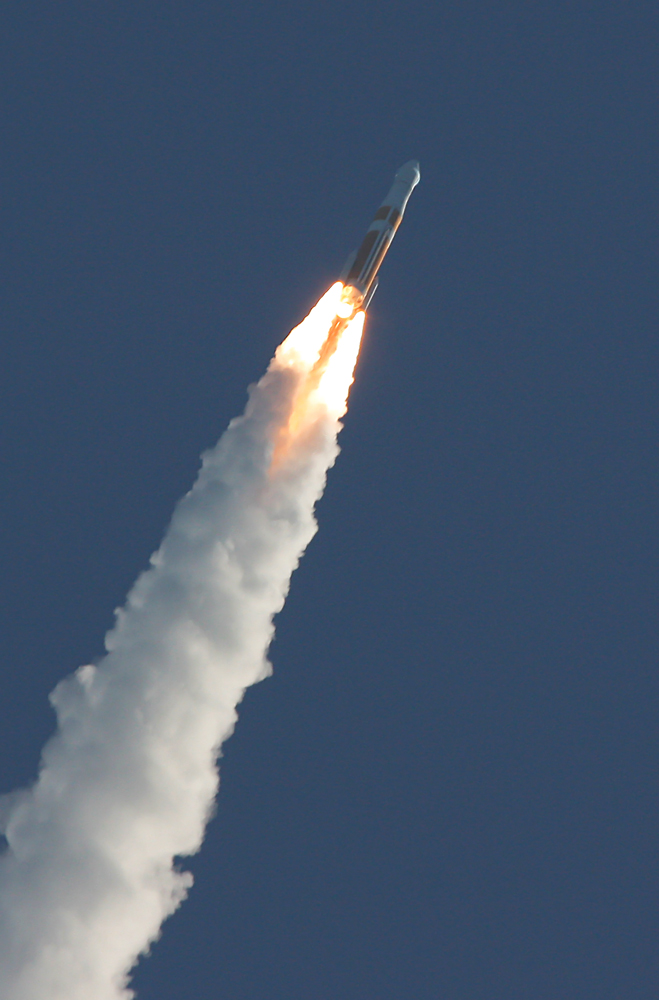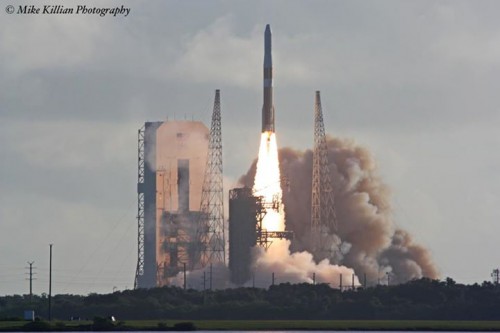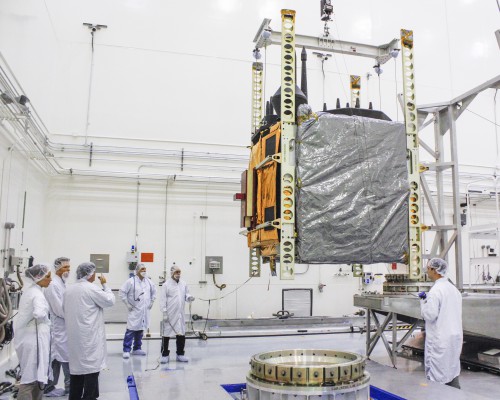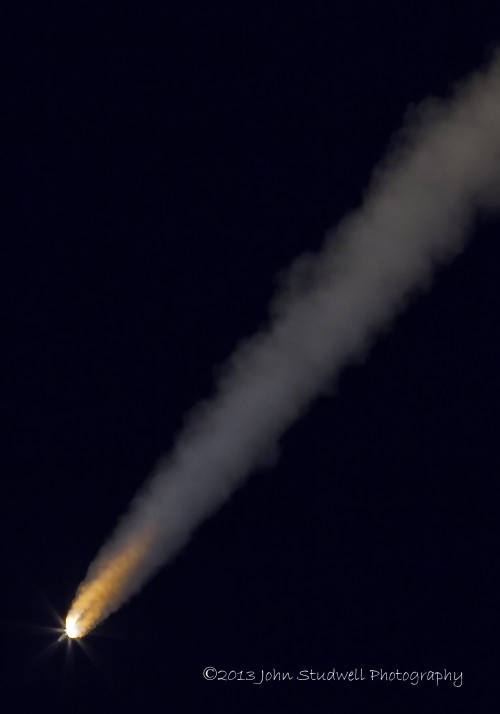
Four months later than planned, United Launch Alliance (ULA) is ready to fly its venerable Delta IV for the 25th time on Thursday, 20 February, with the scheduled 8:40 p.m. EST liftoff of a key mission to insert the Global Positioning System (GPS) IIF-5 satellite into a medium orbit, some 11,047 nautical miles (20,460 km) above Earth. Originally targeted for mid-October 2013, the flight from Space Launch Complex (SLC)-37 at Cape Canaveral Air Force Station, Fla., has met with significant delay, due to corrective work undertaken in the aftermath of a problematic Delta IV ascent in October 2012. Tomorrow’s Delta IV mission will fly in its Medium+ 4,2 configuration, numerically designated to identify a 13-foot-diameter (four-meter) payload fairing and the presence of two solid-fueled Graphite Epoxy Motors (GEM)-60.
As noted, this launch has been a long time coming. In October 2012, a Delta IV Medium+ 4,2 suffered a period of unexpectedly reduced thrust in its Pratt & Whitney Rocketdyne-built RL-10B2 upper stage engine. Fortunately, the rocket’s robust system design, fault-tolerant guidance software, vehicle margins, and propellant reserves compensated for the shortfall and successfully delivered the low-mass GPS IIF-3 primary payload into its correct orbit. However, in pursuit of ULA’s stated goal of “Perfect Product Delivery,” Pratt & Whitney Rocketdyne and the U.S. Air Force convened a joint investigation into the mishap.

Over the next few months, investigators identified the general characteristics of the fuel leak and a number of corrective actions—both in terms of hardware and broader “operational procedures”—were implemented. These included the thorough inspection of engine and Delta IV systems for damage or the presence of foreign objects, coupled with in-flight helium purges to critical components and changes to how the restartable RL-10B2 engine was thermally conditioned during ascent to prepare to its first “burn.” The commonality between the Delta IV’s RL-10B2 and the the RL-10A engine of the Atlas V (which is also operated by ULA) meant that both fleets were grounded, pending a resolution of the problem. However, whilst the Delta IV investigation continued, an Atlas V was cleared to deliver the U.S. Air Force’s X-37B spacecraft into orbit on 11 December 2012.
Finally, late last spring, the Delta IV received a clean bill of health and staged a successful return-to-flight mission on 24 May, delivering the Wideband Global Satcom (WGS)-5 satellite into orbit. Three months later another Delta IV carried WGS-6 aloft, and on 28 August the Delta IV Heavy—currently the United States’ largest and most powerful operational launch vehicle—boosted the National Reconnaissance Office’s NROL-65 classified payload into orbit. Next up was the flight of GPS IIF-5, initially planned for 17 October. Launch was postponed by six days, “to allow technicians time to change out a faulty ground system valve on the liquid oxygen storage tank,” and it appeared that the Delta IV was marching smoothly toward a revised liftoff date of 23 October.
Then, on the 18th, it was announced that the mission had met with further delay. “The team has continued with Phase II of an investigation related to a successful Delta IV launch that occurred in October 2012,” it was explained at the time. “The ongoing Phase II investigation has included extremely detailed characterization and reconstructions of the instrumentation signatures obtained from the October 2012 launch and these have recently resulted in some updated conclusions related to dynamic responses that occurred on the engine system during the first engine-start event. The GPS IIF-5 launch is being delayed to allow the technical team time to further assess these updated conclusions and assess the improvements already implemented and determine whether additional changes are needed.” It was noted that the delay impacted only the Delta IV fleet and that the Atlas V—which was then only weeks away from launching NASA’s Mars Atmosphere and Volatile Evolution (MAVEN) mission—was unaffected.

Although little has emerged from ULA or the Air Force as to how the investigation has progressed, it became clear earlier in 2014 that a late February target date for the return-to-flight mission was likely.
The central component of the vehicle for tomorrow’s mission is a single Common Booster Core (CBC), which stands 134 feet (41 meters) tall and is powered by a single RS-68 liquid oxygen and hydrogen engine, which produces 663,000 pounds (300,000 kg) of thrust at liftoff. This will ignite at T-5 seconds and undergo several seconds of computer-controlled health checks, ahead of the command to fire the GEM-60 boosters at T-0.01 seconds and the release of the hold-down clamps and liftoff at T-0. The Delta IV Medium+ 4,2 configuration of the booster is capable of lofting a payload weighing up to 12,890 pounds (5,850 kg) into a 22,300-mile (35,000-km) geostationary transfer orbit.
Since its first flight on 20 November 2002, the Delta IV has proven to be an exceptionally reliable launcher. Although its maiden voyage—which also flew in the Medium+ 4,2 configuration—despatched the Eutelsat W5 commercial payload into orbit, it has been almost exclusively detailed to serve military customers, carrying satellites for communications, weather monitoring, early-warning, and reconnaissance/intelligence. These have included members of the Global Positioning System (GPS), the Defense Satellite Communications System (DSCS), the Defense Support Program (DSP), the Geostationary Operational Environmental System (GOES), members of the Wideband Global Satcom (WGS) series, the Defense Meteorological Satellite Program (DMSP), and a number of classified National Reconnaissance Office Launches (NROL). Only the first flight of the Delta IV Heavy in December 2004 suffered a premature shutdown of its CBCs, which caused one of its satellite cargoes to enter an incorrect orbit and the other to fail to achieve orbit entirely. Tomorrow’s scheduled launch of GPS IIF-5 will be the 10th occasion on which the Medium+ 4,2 variant has been employed in the Delta IV’s 25-flight history and, with the exception of the October 2012 mishap, the configuration has performed admirably.
Following the liftoff command, the 206-foot-tall (62-meter) Delta IV will be released from the pad surface and begin a fast climb away from SLC-37. About eight seconds after liftoff, the vehicle will execute an automated pitch, yaw, and roll program maneuver to establish itself on the proper 105.28-degree flight azimuth to deliver GPS IIF-5 into orbit. Powered by its RS-68 engine and twin boosters, it will burst through the sound barrier at about T+47 seconds. At one minute into the flight, it will encounter a period of maximum aerodynamic turbulence on the airframe, known colloquially as “Max Q.”
The twin strap-on boosters will be jettisoned about 105 seconds after launch, and the RS-68 will continue to propel the stack toward orbit for a further three minutes. It will shut down and be discarded about four minutes into the flight, after which the Delta Cryogenic Second Stage (DCSS)—powered by Pratt & Whitney Rocketdyne’s RL-10B2 engine—will roar to life and take over with 24,750 pounds (11,220 kg) of propulsive yield. Twelve minutes after leaving SLC-37, the DCSS will achieve an initial “parking orbit” and shut down, then coast for several minutes, before reorienting itself for a second burn. After the completion of the three-minute-long second burn, the DCSS and the GPS IIF-5 payload will coast for three hours, preparatory to a third burn. This final burn will last about two minutes and will position GPS IIF-5 correctly for separation from its 38.5-foot-long (11.7-meter) Payload Attach Fitting (PAF) at about 3.5 hours into the flight. The satellite will be injected into orbit at an altitude of 11,047 nautical miles (20,460 km), inclined 55 degrees to the equator.

Weighing 3,600 pounds (1,630 kg), GPS IIF-5 is the latest in an “interim” class of Global Positioning System satellites to keep a critical worldwide positioning, velocity, and timing asset operational until the next-generation GPS Block IIIA comes online sometime in 2014. The spacecraft boasts improved-accuracy positioning systems, a reprogrammable processor, capable of future upgrades, an interference-free civilian signal for commercial aviation search-and-rescue, and better resistance to electronic jamming through the new “M-code” military GPS signal. The first member of the planned 12-strong constellation of Block IIF satellites was launched in May 2010. It was followed by GPS IIF-2 in July 2011, GPS IIF-3 in October 2012, and GPS IIF-4—aboard an Atlas V—in May 2013.
“As each IIF satellite becomes operational, we continue the seamless transformation of the GPS constellation into an even more accurate, reliable, and durable navigation resource for the U.S. military and the global civilian user community,” said Craig Cooning, vice president and general manager of GPS Block IIF prime contractor Boeing Space & Intelligence Systems. “Our efficient pulse-line manufacturing process, adapted from Boeing’s commercial airplane production lines, also ensures that we deliver each spacecraft on time and on cost.”
In the meantime, the U.S. Air Force awarded Lockheed Martin a $1.4 billion contract in May 2008 to develop the Block IIIA network, which may eventually consist of as many as 32 satellites. At present, the Air Force has formally contracted for four Block IIIAs. With 500 times the transmitter power of current systems, Block IIIA will also benefit from new navigational warfare capabilities, enabling them to shut off GPS service to limited geographical locations whilst maintaining service to U.S. and allied forces. The GPS system is operated and controlled by the 50th Space Wing, located at Schriever Air Force Base, Colo.
Want to keep up-to-date with all things space? Be sure to “Like” AmericaSpace on Facebook and follow us on Twitter: @AmericaSpace
Missions » GPS » GPS IIF-5 »



